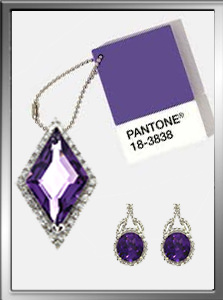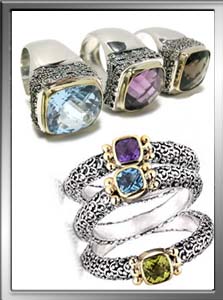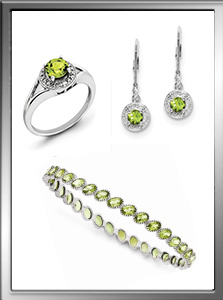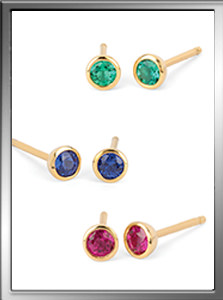The Jewelry Industry Shows It’s Colors in Gemstones
Color Stones a Key Product Category
 The gem market is hitting its stride with fashion, as Pantone’s popular seasonal palettes have consumers clamoring for color.
The gem market is hitting its stride with fashion, as Pantone’s popular seasonal palettes have consumers clamoring for color.
Color stones are an attractive product category to invest in offering a variety of hues, types and price points to choose from; not easily comparison-shopped; yielding larger margins than diamonds, and attracting key demographics like self-purchasing women and millennials getting married.
“Jewelers forget that fashion is a part of jewelry,” says marketing consultant Andrea Hill of the Chicago-based Hill Management Group. “You walk into most jewelry stores and you never see the connection. We’re an industry known for diamond engagement rings when we should be known for color, fashion, and gemstones. Jewelry is part of the way we dress and style ourselves every day.”
Color Me Fashion
A May 2017 study by MVI Marketing through its Jewelry Consumer Council reveals that specialty fine jewelry retailers lag in attracting self-purchasing female shoppers, particularly younger women because they do not see variety, color, or fashion well represented in traditional fine jewelry stores. They also don’t see enough women, especially millennials working there either.
“Women care about fashion and style more than gemology,” says Marty Hurwitz, CEO of the Los Angeles-based jewelry-focused marketing firm. The study reveals that women are interested in color to go with their outfits, with at least one-quarter of self-purchasing women polled expecting to buy jewelry containing a color stone or pearl at least once a year. Over 67% said wearing fine jewelry makes them feel “special”, with more than 91% saying they want to buy more, and nearly 60% said they need no reason or special occasion to do it.
The Pantone colors can help jewelers to market jewelry in new and exciting ways, especially because they go hand-in-hand with fashion and people are paying attention. Pantone resonates with consumers by reinforcing popular colors they see in other product categories.

“Pantone can be a conversation-starter for gems beyond birthstones,” says Amanda Gizzi, director of public relations for Jewelers of America. “Jewelers can take the birthstone story to a new level by introducing non-traditional stones when discussing color and fashion.” She cites gems seen in the latest designs like opal, aquamarine, and topaz; garnet, fire opal, and coral; and emerald, green sapphire, and tourmaline. With “Ultra Violet” Color of the Year, she also expects to see more designs in amethyst, tanzanite, and purple sapphire.
Woman want to be empowered with knowledge and confidence to explore how they can create their own signature style with jewelry, says Atlanta designer Sara Blaine.
She advocates jewelers and helps create displays that show fashions, color swatches, and jewelry together to help customers make the connection between a trend and its jewelry counterpart. She also advises sales associates accessorize in jewelry from stock to show how jewelers’ designs work with the fashions people in their community are wearing. It’s important to create a “guilt-free” experience with designs that complement current fashions and are attainable, advises Alisa Bunger,
director of sales, B88 Division of the Dallas-based Prime Art Jewel, and the Elle Jewelry brand. Research by MVI, as well as National Jeweler magazine in 2017 concurs that the average retail price per unit popular for self-purchase women is under $1,000.
Jewelers should balance trendy with timeless designs, advises Allison Peck, Color Merchants, New York City. “Even for jewelers who think what’s trendy is only for urban areas, jewelers need to carry some fashion with their classic jewelry to show alternatives. Trends are shared online via social media in a way that it doesn’t matter if you live in New York or Alabama people are seeing the trends simultaneously. Customers are walking into stores with pictures in hand.”
With online shopping and social media women are buying more jewelry for themselves, reports Maren Spence, merchandise manager for Ostbye, Minneapolis, Minnesota. “There’s a big opportunity for growth in marketing to self-purchasing women because they are not waiting for men to buy them jewelry like it was positioned in the past. Stores can work on merchandising specifically for this, training staff and posting on social media.”
Millennial Mindset
Color stones add personality says Cora Lee Colaizzi, director of marketing and catalogs and senior merchandiser Quality Gold, Fairfield, Ohio. “Gemstones sell to all ages, all year. Everyone has a favorite color. Jewelers should merchandise cases to draw attention from all purchasers throughout the year.”
Color opens the world of customization, and many brands offer design services to retail partners. “Everybody has a favorite color and color stone jewelry sells year round,” says Colaizzi. “With everyone wanting to be a designer and personalize their jewelry, why not offer custom services in color?”
Next, to the popularity of family jewelry that is all about color and quite popular among self-purchasing women, Colaizzi says Quality Gold’s entire bridal collection is available for custom design. “Every mounting can be designed with a color center or accent stones,” she says, noting an increase in demand for both.” Trends in wedding rings showing more gemstones underscore color’s increasing appeal in jewelry design.
Sapphire, emerald, and ruby are popular choices, but so are birthstones, as well as blush tone  like morganite and light topaz. According to 2015 research by The Knot, nearly 10% of engagement rings feature a non-diamond precious stone. Many believe that percentage is higher today. Millennials, more than previous generations will consider things other than diamonds for wedding rings, especially color stones because they’re unique and personal.
like morganite and light topaz. According to 2015 research by The Knot, nearly 10% of engagement rings feature a non-diamond precious stone. Many believe that percentage is higher today. Millennials, more than previous generations will consider things other than diamonds for wedding rings, especially color stones because they’re unique and personal.
A Refinery29 article last March hails “Millennials Are All Buying This Type of Ring,” showing images of gems like tourmaline and opal. The piece says more young couples are choosing colorful stones for their wedding jewelry over diamonds. The piece highlights words like unusual, original, non-traditional, and reflecting one’s own love story to describe why millennials are attracted to color.
Couples choose gemstones for many reasons including self-expression and personalization, ethical views (caring about sustainable and transparent supply chain), and economics (more bang for the buck).
